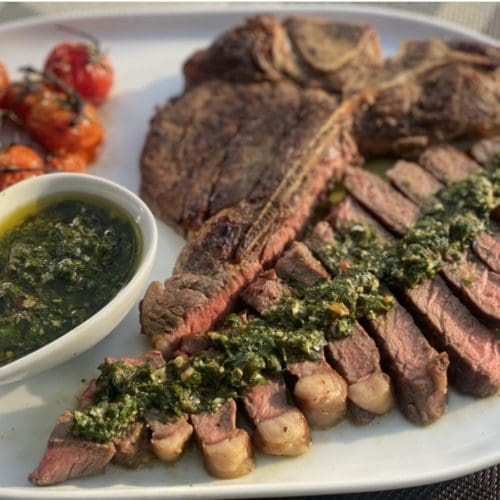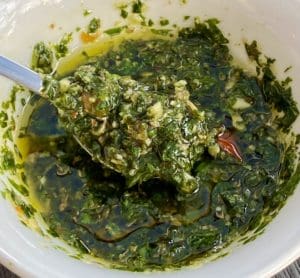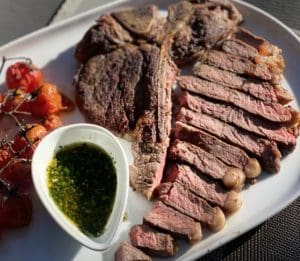
Chimichurri Steak
Chimichurri Steak may sound & look complicated, but it isn't. A mouthwatering meal of steak & tasty chimichurri sauce in less than 20 minutes!
Ingredients
- 2 T-bone steak (approx. 500gm/1.1lb each) (NOTE 1)
- salt and pepper to season
- 2 tbsp vegetable oil (or canola oil)
For the Chimichurri
- 1 cup flat-leaf parsley leaves
- ⅓ cup mint
- 1½ tsp dried oregano (or 2 tbsp of fresh oregano)
- 3 cloves garlic
- 1 medium red chilli
- ¼ cup red wine vinegar
- 1 tbsp honey (NOTE 2)
- ½ tsp salt
- ½ cup extra virgin olive oil
Instructions
- Leave the steaks to rest at room temperature for 30 minutes prior to cooking. For the chimichurri sauce - Place the ingredients for the chimichurri (except for the olive oil) into a food processor and blitz for 20 seconds or until finely chopped. Transfer the mixture into a bowl and pour in the olive oil, then stir to combine.

- Pat the steaks dry with paper towels, then sprinkle the entire steak generously with salt and pepper.Heat vegetable oil in a large frying pan over high heat. Once the oil smokes, place the steak in the pan. Every 15-20 seconds, Turn the steaks over every 15-20 seconds until they're cooked to your liking. If possible, use a meat thermometer to help determine the 'doneness' of your steak. Place the steaks on a wire rack to rest for 5 minutes before serving.

Notes
Herbs - I used a blend of flat-leaf parsley, mint and dried oregano. If you wish to keep your chimichurri traditional, just use a blend of parsley and fresh or dried oregano.
(NOTE 1) Steak - I used 2 x 500gms/1.1lb of T-Bone steaks to share with 4 people. If you prefer to serve the steaks individually, get ones that are approximately 250-300g (9-11oz) each. Ideal steak cuts for pan-frying are porterhouse, scotch fillet, rib eye, NY strip, sirloin and T-Bone.
(NOTE 2) Honey (optional) - This chimichurri-inspired sauce came from our local steakhouse. They used honey to add a subtle sweetness, and it also smooths out the harsh taste of the vinegar in the chimichurri sauce. I recommend this, but if you like your chimichurri traditional and more sour than sweet, simply omit the honey.
Serving suggestions - Serve the chimichurri sauce over the steak or in a little bowl beside the steak. Fries, mashed potatoes, salad or vegetables make great side dishes for this Chimichurri Steak.
Leftovers - Place the chimichurri in a sterilised jar and keep it in the fridge for up to 3 days
I've used a third-party application to calculate the calories and nutritional information, so please use this as an approximate guide only.
Cooking measurements are in Australian standard spoon and cup measurements. For specific details and conversions, visit our Australian Cooking Measurements page.
Nutrition
Serving: 1servingCalories: 594kcalCarbohydrates: 8gProtein: 36gFat: 59gSaturated Fat: 15gPolyunsaturated Fat: 8gMonounsaturated Fat: 32gTrans Fat: 0.04gCholesterol: 95mgSodium: 396mgPotassium: 693mgFiber: 1gSugar: 5gVitamin A: 1543IUVitamin C: 38mgCalcium: 59mgIron: 5mg